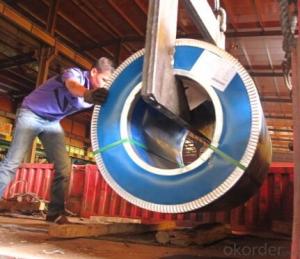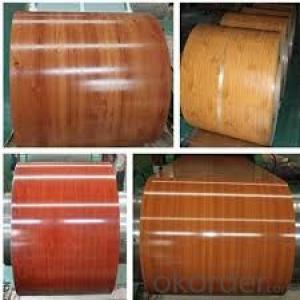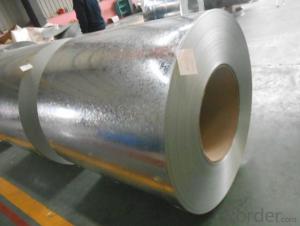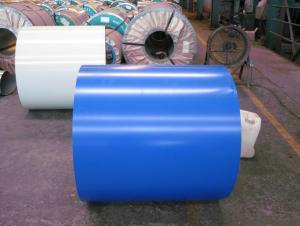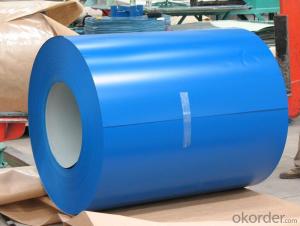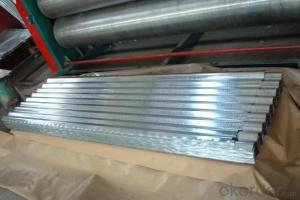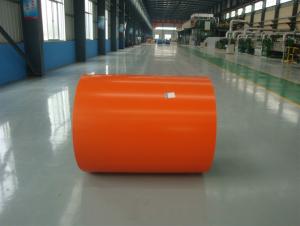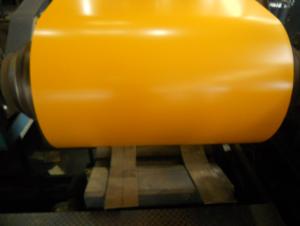Pre-painted Aluzinc Steel Coils Color Coated for Wholesales
- Loading Port:
- Tianjin
- Payment Terms:
- TT OR LC
- Min Order Qty:
- 10 m.t.
- Supply Capability:
- 1000 m.t./month
OKorder Service Pledge
OKorder Financial Service
You Might Also Like
1.Description of Pre-painted Aluzinc Steel Coils:
Galvanized steel coil can be used outside because of its natural ability to avoid rust or corrosion. The coil itself is usually available in different dimensions. It may range from from 6 inches to 24 inches wide (15 cm to 51 cm), and up to 10 feet (3 m) long when rolled out flat.
2.Attentions in transportation and storage :
1)PPGI/PPGL should be stored in neat and tidy environment to avoid possible corrosion caused by all kinds of corrosive medium.
2)The ground for storage should be flat, without hard object, and with sufficient loading-bearing capacity.
3)Storage environment should be dry and ventilated. Avoiding storing outdoors or with dew or with wide temp difference.
4)Coil could not be dragged lest the burr caused by slicing will scratch the coil surface underneath. Coil should be handled with care, without hitting any hard objects.
3.Photo of Pre-painted Aluzinc Steel Coils:

4.Pre-painted Aluzinc Steel Coils Specification:
Product Name | Galvanized Steel plate |
Thickness | 0.14mm-4.0mm |
Thickness Tolerance | +/-0.03mm |
Width | 600-1500mm |
Width Tolerance | +/-0.5mm |
Length | 1000-6000mm |
Zinc Coating | z60-z275 g/m2 |
Standard | ASTM, AISI, DIN, GB, BS, JIS |
Material | SGCC,DC51D,DX52D,DX53D,,SGCD,Q195,Q235,SGHC,DX54D, S350 GD, S450 GD,S550 GD |
Spangle | zero spangle, regular spangle or normal spangle, small spangle, big spangle |
Surface Treatment | Chromated and oiled, Chromated and non-oiled, Anti-finger, Dry, Bright |
5.FAQ
We have organized several common questions for our clients,may help you sincerely:
①How about your company?
A world class manufacturer & supplier of castings forging in carbon steel and alloy steel,is one of the large scale professional investment casting production bases in China,consisting of both casting foundry forging and machining factory. Annually more than 8000 tons Precision casting and forging parts are exported to markets in Europe,America and Japan. OEM casting and forging service available according to customer’s requirement.
②How to guarantee the quality of the products?
We have established the international advanced quality management system,every link from raw material to final product we have strict quality test;We resolutely put an end to unqualified products flowing into the market. At the same time, we will provide necessary follow-up service assurance.
③How long can we receive the product after purchase?
In the purchase of product within three working days, We will arrange the factory delivery as soon as possible. The pecific time of receiving is related to the state and position of customers.Commonly 7 to 10 working days can be served.
- Q: Nickel is ferro magnetic in nature. But when it is added with stainless steel, it makes stainless steel non-magnetic. What is the structural changes happened with the presence of nickel?
- Steel is magnetic because of the alignment of the spin in the electrons of the atoms in the crystaline matrix of the steel. Nickel atoms are not the same size as Iron atoms and Chromium atoms. by having several different sizes of atoms in the alloy, it prevents a uniform crystaline matrix from being formed. If you imagine a box of marbles that are all the same size, they will all settle into a regular pattern in the box. But a bunch of mismatched marbles will be jumbled together in irregular patterns. This prevents the magnetic properties of either element from asserting itself.
- Q: What is the weight range of steel coils?
- The weight range of steel coils can vary greatly depending on the specific type and dimensions of the coil. However, typically, steel coils can weigh anywhere from a few hundred kilograms to several tonnes.
- Q: How are steel coils used in the production of electrical relays?
- Steel coils are used in the production of electrical relays as they provide the necessary magnetic field required for the relay to function. When an electric current passes through the coil, it generates a magnetic field, which then attracts or repels the relay's switch mechanism. This coil-based mechanism allows relays to control the flow of electricity in various electrical circuits.
- Q: full discription about hydrolics used in steel melting shop with hyd valve is use in thair circit too ?
- The correct spelling is hydraulics. I haven't heard the term steel melting shop you probably means a foundry or a steel mill The most obvious example i can think of is hydraulic-operated fork lifts. Hydraulic cylinders are used to lift the forks and to tilt them upwards or downwards. The valves are coneccted to levers next to the steering wheel. Hydraulic pressure is supplied by a hydraulic pump driven by a propane or diesel engine. In some forklift designs the wheels are also not connected directly to the engine, but driven by hydraulic motors. There are also a large variety of machines used in steel mills and metalworking companies to cut and shape metal parts. for example, press brakes, plate cutting shears, stamping presses, hole punch machines, drawing presses, etc. These types all operate in much the same basic way. They use a very large cylinder or group of cylinders to apply many tons of force to different kinds of metal working tools.
- Q: Why are properties of steel not identical?
- Grade 440C is one of the highest strength stainless steels. It is also very wear resistant. Good for use as ball bearings and other high wear applications. 400C has the highest carbon content of the 440 steels. 440A and 440B are identical but have lower carbon contents and have lower strengths and higher corrosion.
- Q: How are steel coils used in the production of automotive parts?
- Steel coils are used in the production of automotive parts as they are processed and shaped into various components such as body panels, chassis, and structural parts. These coils are typically unrolled, cut, and formed into the desired shape using specialized machinery. The flexibility, strength, and durability of steel make it an ideal material for manufacturing automotive parts, ensuring safety and reliability in the finished products.
- Q: What are the common thicknesses available for steel coils?
- The specific requirements and applications determine the available common thicknesses for steel coils. However, various industries commonly produce and use certain standard thicknesses. Typically, steel coils can range in thickness from 0.005 inches to 0.5 inches or more, depending on the type of steel and its intended use. For instance, in automotive manufacturing, where steel coils are utilized for body panels and structural components, the thicknesses commonly range from 0.5 mm (0.020 inches) to 3 mm (0.118 inches). In the construction industry, steel coils are employed for roofing, siding, and structural framing. The common thicknesses can vary from 0.014 inches to 0.062 inches, depending on the specific application and structural requirements. Similarly, appliances manufacturing, such as refrigerators, washing machines, or HVAC systems, frequently employ steel coils with thicknesses ranging from 0.018 inches to 0.035 inches. It is important to note that these are only a few examples of common thicknesses, and variations can occur based on the specific requirements of different industries and applications. Custom thicknesses can also be produced upon request to meet unique needs in various sectors.
- Q: How are defects in steel coils detected and resolved?
- Defects in steel coils are typically detected through visual inspections, as well as non-destructive testing techniques such as ultrasonic testing and magnetic particle inspection. Once identified, the defects can be resolved through various methods including grinding, welding, or cutting and replacing the affected area. The specific resolution method depends on the nature and severity of the defect.
- Q: What are the different methods of edge wave correction for steel coils?
- There are several methods commonly used to correct edge waves in steel coils. These methods aim to eliminate or minimize the occurrence of edge waves, which are deformations that can occur along the edges of steel coils during processing or handling. One of the most common methods is called edge wave flattening. This technique involves using hydraulic or mechanical devices to apply pressure to the edges of the coil, effectively flattening out any waves or deformations. This can be done during the coil processing stage or as a separate step after the coil has been produced. Another method is known as edge trimming. In this approach, the edges of the coil are trimmed or cut to remove any waves or deformations. This can be done through mechanical shearing or using laser cutting technology. Edge trimming not only corrects the edge waves but also ensures that the coil has straight and smooth edges. Additionally, tension leveling is another popular method for edge wave correction. This technique involves subjecting the coil to tension forces, which helps to stretch and flatten out any waves or deformations. Tension leveling is typically done during the processing stage and is effective in correcting both edge waves and other surface defects. Moreover, roll leveling can be employed to correct edge waves in steel coils. This method utilizes a set of rolls to apply pressure to the coil, gradually flattening out any waves or deformations. Roll leveling is a versatile technique that can be used for various types of coil defects, including edge waves. Lastly, technology advancements have led to the development of automated edge wave correction systems. These systems utilize sensors and computer algorithms to detect and correct edge waves in real-time during the coil processing stage. This method ensures precise and consistent correction, minimizing the need for manual intervention and improving overall efficiency. Overall, the different methods of edge wave correction for steel coils include edge wave flattening, edge trimming, tension leveling, roll leveling, and automated correction systems. Each method has its own advantages and can be chosen based on the specific requirements and constraints of the coil processing operation.
- Q: What are the common uses of galvanized steel coils?
- Galvanized steel coils are commonly used in various industries such as construction, automotive, and manufacturing. They are primarily used for making metal roofs, walls, and fences due to their corrosion-resistant properties. Additionally, galvanized steel coils are utilized in the production of air conditioning ducts, electrical appliances, and agricultural equipment.
Send your message to us
Pre-painted Aluzinc Steel Coils Color Coated for Wholesales
- Loading Port:
- Tianjin
- Payment Terms:
- TT OR LC
- Min Order Qty:
- 10 m.t.
- Supply Capability:
- 1000 m.t./month
OKorder Service Pledge
OKorder Financial Service
Similar products
Hot products
Hot Searches
Related keywords
